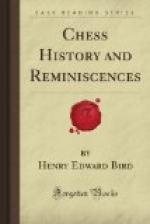Eminent contributors to the Archaeologia, F. Douce, 1793, and Sir F. Madden, 1828, adopt the conclusions of Dr. Hyde and Sir William Jones and they receive confirmation from native works of this century, and incidentally from Sanskrit scholars who wrote not as chess players.
Duncan Forbes, L.L.D., Professor of Oriental languages in King’s College, London, is the next great authority upon the Chaturanga; in a work of 400 pages published in 1860 dedicated to Sir Frederic Madden and Howard Staunton, Esq., he further elaborated the investigations of Dr. Hyde and Sir William Jones and claimed by a better acquaintance with chess and choice of manuscripts and improved knowledge of the Sanskrit language to have proved that the game of chess was invented in India and no where else, in very remote times or, as he finally puts it at page 43: “But to conclude I think from all the evidence I have laid before the reader, I may safely say, that the game of chess has existed in India from the time of Pandu and his five sons down to the reign of our gracious Sovereign Queen Victoria (who now rules over these same Eastern realms), that is for a period of five thousand years and that this very ancient game, in the sacred language of the Brahmans, has, during that long space of time retained its original and expressive name of Chaturanga.”
The Chaturanga is ascribed to a period of about 3,000 years before our era.
According to the Sanskrit Text of the Bavishya Purana from which the account is taken, Prince Yudhisthira the eldest and most renowned of the five sons of King Pandu, consulted Vyasa, the wise man and nestor of the age as to the mysteries of a game then said to be popular in the country, saying:
“Explain to me, O thou super-eminent in virtue, the nature of the game that is played on the eight times eight square board. Tell me, O my master, how the Chaturaji (Checkmate) may be accomplished.”
Vyasa thus replied:
“O, my Prince, having delineated a square board, with eight houses on each of the four sides, then draw up the red warriors on the east, on the south array the army clad in green, on the west let the yellow troops be stationed, and let the black combatants occupy the north.




